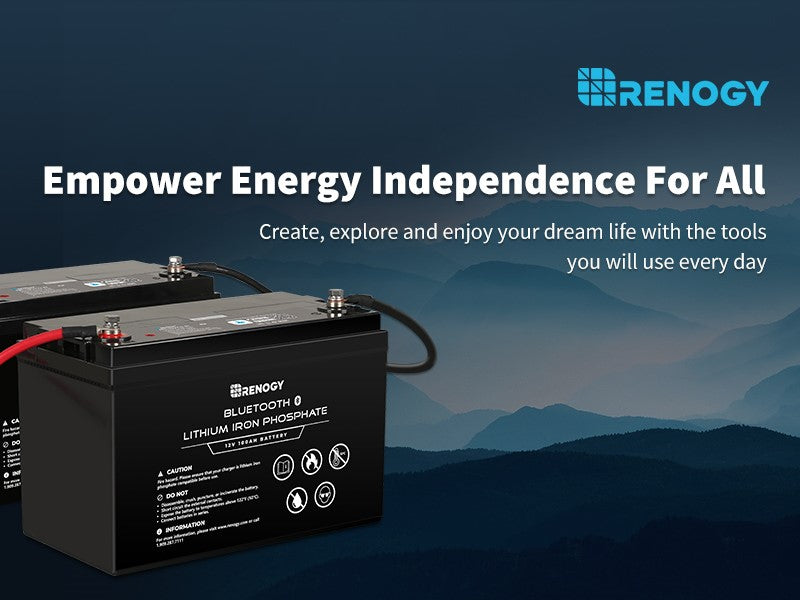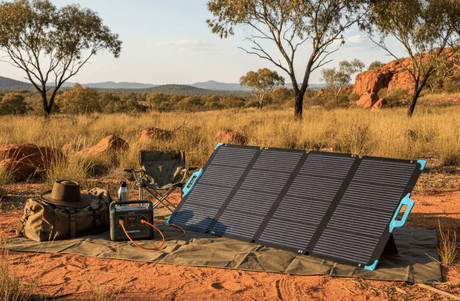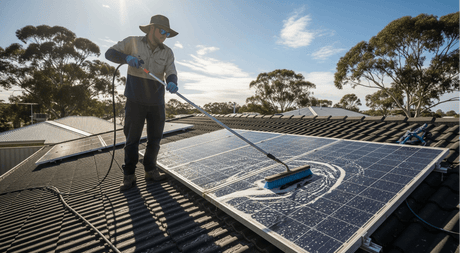Lithium iron phosphate (LiFePO4) batteries may sound similar to the more standard lithium-ion battery you know and use in various devices. However, these relatively new energy storage battery packs have some significant benefits that lithium-ion batteries can’t offer.
Even with a comparable chemical composition, lithium iron phosphate batteries outperform lithium-ion batteries in cycle life, cell density, and environmental impact.
Let’s dive into the details about LiFePO4 batteries and why they are the latest and greatest option power sources for solar panels.
What Is a Lithium Iron Phosphate Battery?
A lithium iron phosphate (LFP) battery does not use battery acid or rare metals like other battery power sources. It differs from a traditional lithium-ion battery by using a phosphate-based cathode to draw in electrons from an external circuit rather than an iron cathode.
Using phosphate makes the battery much more thermally and chemically stable. That means lithium iron phosphate batteries users don’t need to concern themselves with batteries overheating or exploding.
A lithium iron phosphate battery can easily withstand temperatures up to 65 °C without any damage occurring. This feature is partly what makes them so popular in solar panel kits and other devices such as computers, smartphones and watches, electric car batteries, and marine batteries.
Benefits of a Lithium Iron Phosphate Battery
Their ability to withstand high temperatures is part of what makes lithium iron phosphate batteries advantageous. But what other benefits do they have to offer, and are they worth it compared to lead-acid batteries or lithium-ion batteries?
Let’s see what makes these batteries so great for solar panel installation or DIY solar projects.
Less Cell Density
The more density a battery has, the longer it can operate. That statement may have you wondering why we’ve listed less cell density as a benefit of lithium iron phosphate batteries. The overall density is dependent on the amount of space the battery has to store power. While LiFePO4 batteries have a lower cell density than lithium-ion batteries, it’s easy to compensate for this by making the LiFePO4 batteries slightly bigger.
The major trade-off for a marginally larger battery is safety. Because lithium iron phosphate batteries have less cell density, they won’t overheat, even when you’re using them in a home or office setting that likely requires a higher voltage.
If you’re curious to know how much voltage your solar setup will probably need to produce to meet your demands, you can use our solar panel calculator. This information will also ensure you choose the best battery chargers.
Longevity
The chemical composition of lithium iron phosphate batteries gives them a longer life than other options currently on the solar battery market.
Compared to lithium-ion batteries, for example, LiFePO4 batteries have a cycle life up to four times longer.
This longevity can provide you with peace of mind that your battery management system (BMS) won’t become worthless during a blackout due to a dead battery pack. It will also save you money in the long term as you won’t have to spend as much as soon to replace your old batteries.
On top of that, solar panels maintenance is a breeze when you’ve got lithium iron phosphate batteries connected to your system. You can set up your BMS just about anywhere, including an outbuilding, storage space, or garage. They’ve even got a high level of water resistance, so you don’t have to worry about keeping an eye on them during bad weather.
Environmental Advantages
Having a clean, renewable energy source like a solar panel system on your property already creates a huge environmental advantage. That’s the main reason why the Australian government offers solar panel rebates and incentives to homeowners and businesses looking to go greener.
Unfortunately, one aspect of solar design that isn’t always so eco-friendly is the introduction of batteries to the system. Batteries contain toxic materials that can seep into the soil and groundwater when disposed of improperly. Mining the raw materials used to produce batteries also adversely impacts the environment.
Lithium iron phosphate batteries are like other batteries. They don’t contain any materials classified as “toxic,” so their overall impact on the environment is already less destructive. It’s also much easier to recycle LiFePO4 batteries and to make them from recycled materials, which creates less waste for landfills. They also have a longer lifespan than other types of batteries, so users won’t need as many of them, again reducing waste and overall environmental impacts.
Depth of Discharge and Discharge Rate
If your lithium iron phosphate batteries end up fully discharged, you won’t have to worry about them getting damaged like other battery types would. Their delivery capacity isn’t affected if they are completely discharged, and they can discharge at varying rates. These features make them ideal for solar energy setups that will rely on more than one battery.
Another way LiFePO4 batteries outperform standard lithium-ion batteries is with their discharge rate. Lithium iron phosphate batteries discharge at a higher and steadier rate, which means that they are better at taking over a grid-tied system during a sudden blackout.
Regardless of how much power and how quickly the system needs it, LiFePO4 batteries will be able to cope without concern.
Cost
So these batteries sound like a dream—what’s the catch? They must be costly, right? Even though they are the latest in battery technology, their prices continue to drop, making them a highly economical option for solar panel energy systems.
Part of why LiFePO4 batteries are already becoming cheaper than some alternatives is due to their chemical and material make-up. Without any highly hazardous or expensive raw materials and their recyclable capabilities, producing and manufacturing these batteries is more economical.
For instance, lithium-ion batteries require cobalt, a relatively expensive raw material, whereas lithium iron phosphate batteries do not. And the longer life span of LiFePO4 batteries means savings for the consumer since they won’t need to replace them as frequently.
A lot of time and research is being put into these batteries so that they can evolve even faster, which will only make them more inexpensive as time goes on. When it comes to deep cycle batteries, it doesn’t get better than lithium iron phosphate.
Operational and Technical Specs
If you’re convinced that LiFePO4 batteries are the way to go, you’ll want to become knowledgeable about how they operate and what their technical specifications are. With this in mind, here are the general specifications of Renogy’s smart lithium iron phosphate batteries, followed by some useful operational details.
While they come in different specifications, the most common LiFePO4 battery for solar purposes has a capacity of 100Ah and a nominal voltage of 12.8 V. That means at a depth of discharge of 80%, you can count on 2,000 life cycles for your battery.
It’s even possible to run them at a DOD of 100%, since you don’t have to worry about them overheating. Their maximum continuous discharge current is 100 A, and their maximum continuous charge current is 50 A.
Even though they might be slightly larger in size, they only weigh about half of a standard lead-acid battery of the same capacity. Renogy’s LiFePO4 batteries are IP65 water-resistant, so they’re great for RV, marine, and cabin solar systems.
Charging a LiFePO4 battery won’t always take the same amount of time, but it’s best to give the battery a day to charge fully. Once fully charged, the battery will hold its power for a prolonged period of time, so you likely won’t have to worry about it fully discharging again any time soon.
For operating purposes, you can use these batteries in parallel with up to eight batteries total, so they’re excellent for more expansive solar panel setups. Each battery has an auto-balancing function to improve its charging efficiency, as well.
To connect LiFePO4 batteries in parallel, you’ll need interconnected cables in which you match the positive terminals and the negative terminals. Paralleling always requires you to use batteries of the same model and manufacturer that don’t have a significant voltage difference, so make sure that you have what you need on hand before connecting them.
Once you have the positive and negative terminals connected, you’ll use tray cables and inverter cables to attach the charge controller and inverter on opposite ends of the battery. Now, you’re ready to switch each battery into “active mode” (since it comes from the manufacturer in “shelf mode” for safety purposes).
Since you can purchase Renogy’s LiFePO4 batteries with smart capabilities, you may also need to connect your Bluetooth module to the up port of your battery. If you’ve got batteries in parallel, connect it to the first one
Using the DC Home app on your smartphone to pair your Bluetooth module means you can now track your battery bank remotely.
Advanced Energy Storage
LiFePO4 batteries provide owners with a plethora of benefits that other battery types can no longer match. They are more environmentally friendly, last longer, and are easier to maintain. They are also still a viable option if you’re looking to run your batteries in parallel, making them a worthy investment for any solar setup in Australia.







![What Is a DC to DC Battery Charger [Comprehensive Guide]](http://au.renogy.com/cdn/shop/articles/IMG_3829_bd86de74-31d6-49fd-b9d5-265bb723091d.jpg?v=1757582605&width=460)


